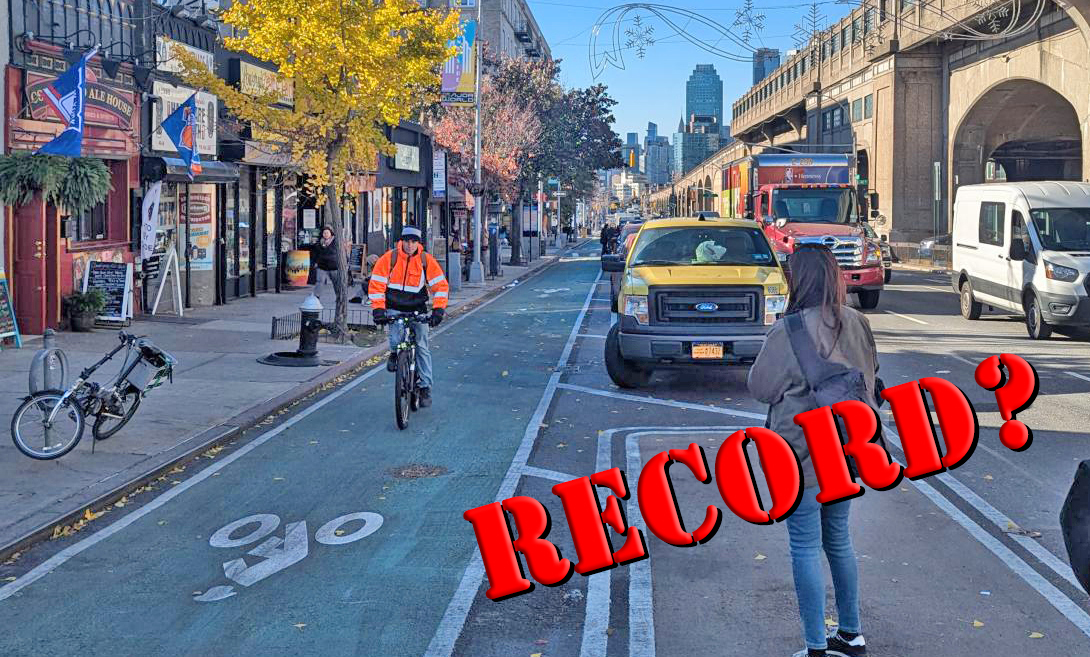
Last night, Streetsblog and the New York Transit Museum hosted a discussion on the future of Bus Rapid Transit in New York. Mayor de Blasio has pledged to implement "world-class" BRT, and DOT Commissioner Polly Trottenberg has promised a stepped-up timetable for expansion of Select Bus Service, New York's brand of enhanced bus. But what will it take to get us there? Joan Byron of the Pratt Center for Community Development, Eric Beaton of NYC DOT, and Robert Thompson of New York City Transit joined Streetsblog Editor-in-Chief Ben Fried to talk about how Select Bus Service has progressed in NYC and where the program is headed.
SBS has its origins in studies that DOT, the MTA, and New York State DOT began in 2004. Today, the program has become a fixture, outlasting electoral changes and turnover at the top of agencies, Beaton noted, but at first it was a tenuous proposition, involving collaboration between government bureaucracies that rarely spoke to each other.
New leadership at DOT gave the program a jolt in 2007. “When suddenly there was a decision at the tops of the agencies that 'Let’s do something,' people were ready to go," Thompson said. In 2008, the first SBS route went live on Fordham Road. Now there are seven SBS lines in all five boroughs, with several more in the planning phases.
SBS routes include a mix of camera-enforced painted bus lanes, off-board fare collection, signal priority for buses at intersections and curb extensions at bus stops. This suite of improvements has been deployed, to varying degrees, on each SBS route since 2008, and transit speeds have increased 15 to 23 percent on those corridors. More full-fledged BRT alignments separate buses from private car traffic to a greater degree, but last night's panelists offered some reasons why that model may not work on many streets.
New York doesn't have the street width that cities like Bogota can use to carve out space for separated busways with express and local service, and the city's lack of side alleys means curb access for necessary deliveries like oil trucks has to be maintained. Center-running transit lanes are an option, but present downsides for local bus service. DOT had considered center-running BRT on Webster Avenue in the Bronx, which would have involved more left-turn restrictions on other traffic, then opted for "offset" bus lanes next to the parking lane. "At least for that particular corridor, the downsides were not worth the upsides," Beaton said.
Given already-high ridership on New York City bus routes, Byron said the bus program should focus on changes that improve trips for the greatest number of riders, targeting bus lane upgrades where they're most needed. The Pratt Center has released a series of reports on the need for to improve bus service for low-income New Yorkers with long commutes, who primarily live beyond the reach of the subway.
One SBS project that may look different than what's come before is Woodhaven Boulevard, a major north/south bus route in Queens. DOT is installing a first round of bus lanes there this fall before unveiling a larger plan for Select Bus Service. The Woodhaven budget is expected to be much bigger than the typical SBS project, and Beaton explained that's because it will likely involve a wholesale redesign of the street.
“It’s an incredibly dangerous street. Pedestrians [there] have some of the highest crash and death rates in the city. Even for drivers, it’s a very difficult street," Beaton said. “To do something good for buses, it’s not as simple as saying, that lane should be a bus lane.”
Advocates have been pushing for center-running BRT on Woodhaven in particular. Although it has run into some community board opposition, the Woodhaven project has an unlikely backer in Council Member Eric Ulrich, a Republican representing southeast Queens who penned an op-ed in support of BRT with Byron.
"I think he wants world-class BRT," Byron said, adding that Ulrich was upset that the first round of bus lanes didn't go further. "He's aware of the safety issues [on Woodhaven], he's aware of [bus] performance issues. He's all the way there," she said.
Political support is key to seeing these projects through to the finish line. While the agencies don't look for unanimity among all elected officials and community boards along a project corridor, they will focus their energy elsewhere if no one speaks up in support. "We're going to put our resources where we can do a project," Beaton said. When the agencies encounter a group who opposes an SBS route, he added, "It does make a huge difference when you have community leaders in place who very actively and very publicly say, 'No, that group does not speak for everyone in the community.'"
The proposal for SBS on 125th Street in Harlem, for example, was almost derailed by opposition, but was rescued in part by supportive elected officials, including Council Member Mark Levine, State Senator Adriano Espaillat, and Speaker Melissa Mark-Viverito.
The agencies now have several years of experience shepherding SBS projects to completion. Trottenberg's stated goal of implementing a dozen more SBS lines in four years would significantly accelerate the pace. The people planning the projects say they're up for it. “Over the past few years, we've learned from our mistakes," Thompson said.





